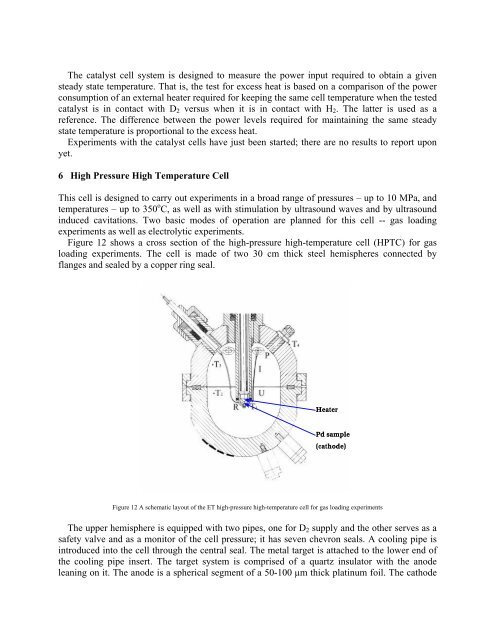Intensification Of Low Energy Nuclear Reactions ... - LENR-CANR
Intensification Of Low Energy Nuclear Reactions ... - LENR-CANR
Intensification Of Low Energy Nuclear Reactions ... - LENR-CANR
Create successful ePaper yourself
Turn your PDF publications into a flip-book with our unique Google optimized e-Paper software.
The catalyst cell system is designed to measure the power input required to obtain a given<br />
steady<br />
state temperature. That is, the test for excess heat is based on a comparison of the power<br />
consumption<br />
of an external heater required for keeping the same cell temperature when the tested<br />
catalyst is in contact with D2 versus when it is in contact with H2. The latter is used as a<br />
reference. The difference between the power levels required for maintaining the same steady<br />
state temperature is proportional to the excess heat.<br />
Experiments with the catalyst cells have just been started; there are no results to report upon<br />
yet.<br />
6 High<br />
Pressure High Temperature Cell<br />
s in a broad range of pressures – up to 10 MPa, and<br />
mperatures – up to 350 o This cell is designed to carry out experiment<br />
te<br />
C, as well as with stimulation by ultrasound waves and by ultrasound<br />
induced cavitations. Two basic modes of operation are planned for this cell -- gas loading<br />
experiments as well as electrolytic experiments.<br />
Figure 12 shows a cross section of the high-pressure high-temperature cell (HPTC) for gas<br />
loading experiments. The cell is made of two 30 cm thick steel hemispheres connected by<br />
flanges<br />
and sealed by a copper ring seal.<br />
Heater<br />
Pd sample<br />
(cathode)<br />
Figure 12 A schematic layout of the ET high-pressure high-temperature cell for gas loading experiments<br />
The upper hemisphere is equipped with two pipes, one for D2 supply and the other<br />
serves as a<br />
safety<br />
valve and as a monitor of the cell pressure; it has seven chevron seals. A cooling pipe is<br />
introduced<br />
into the cell through the central seal. The metal target is attached to the lower end of<br />
the cooling pipe insert. The target system is comprised of a quartz insulator with the anode<br />
leaning on it. The anode is a spherical segment of a 50-100 µm thick platinum foil. The cathode












